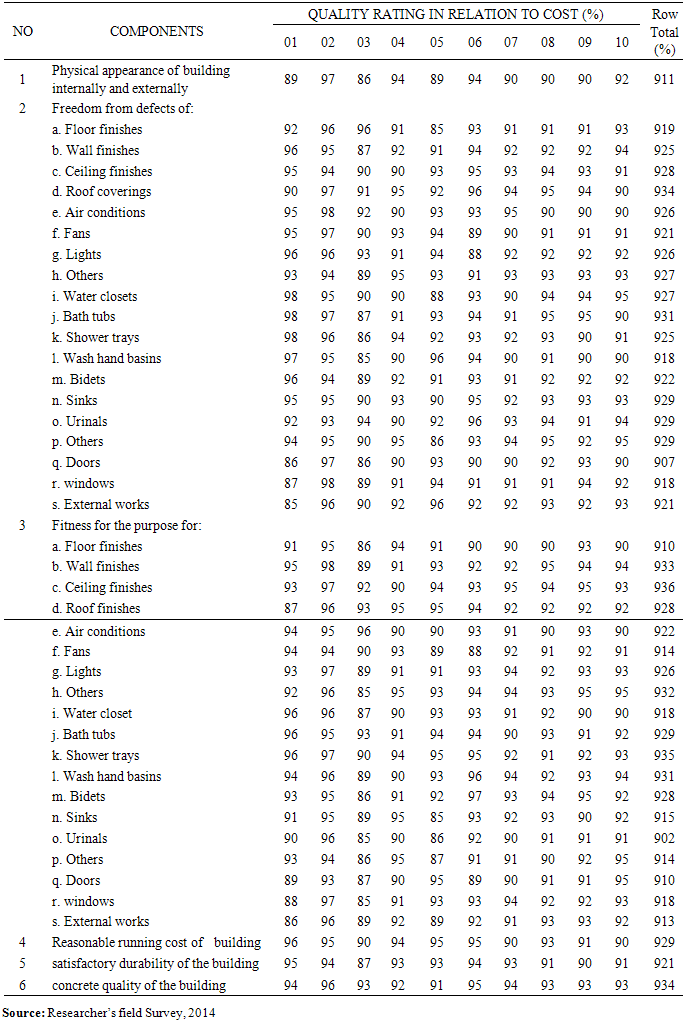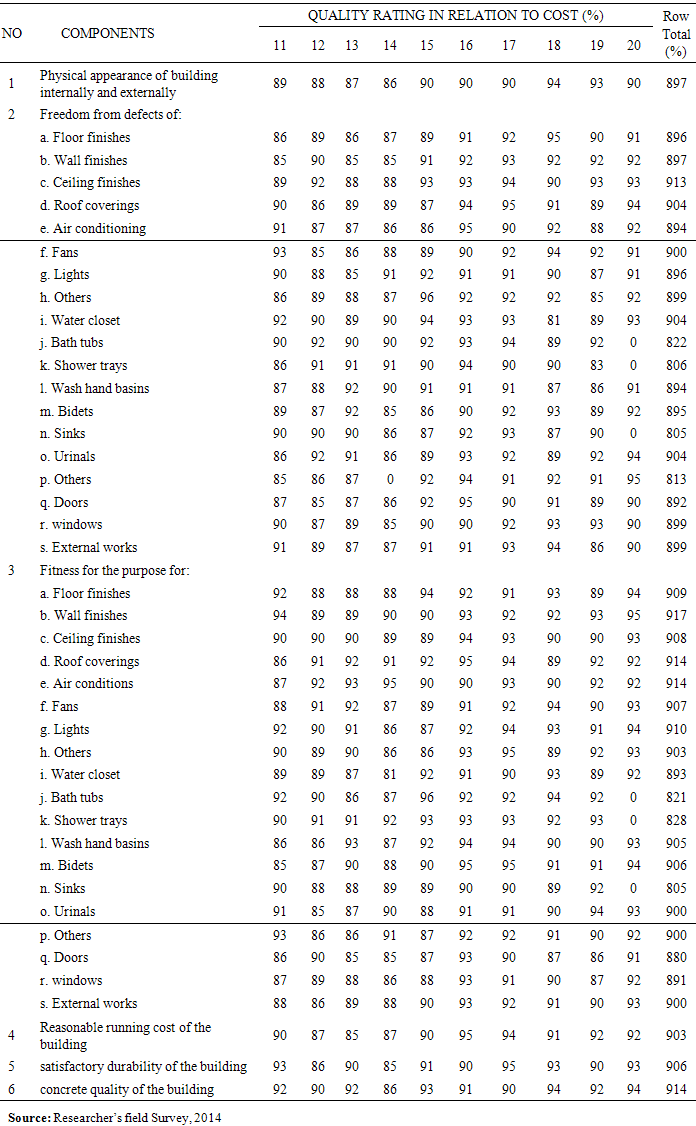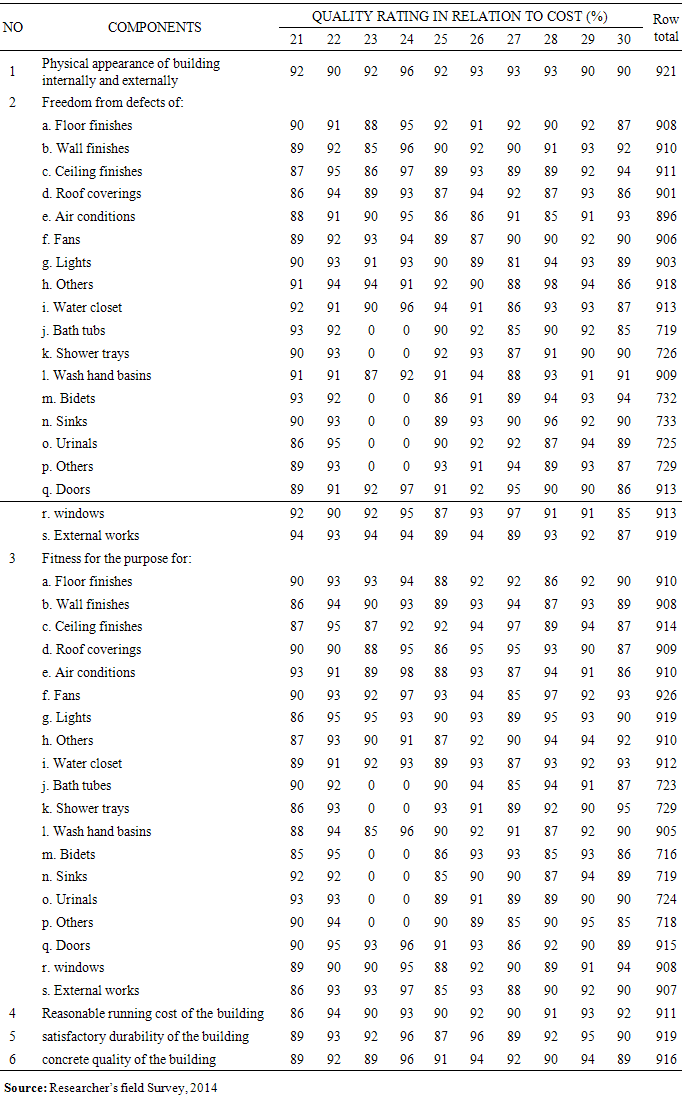-
Paper Information
- Paper Submission
-
Journal Information
- About This Journal
- Editorial Board
- Current Issue
- Archive
- Author Guidelines
- Contact Us
International Journal of Construction Engineering and Management
p-ISSN: 2326-1080 e-ISSN: 2326-1102
2015; 4(2): 35-43
doi:10.5923/j.ijcem.20150402.01
Analysis of Cost and Quality Relationship of Private Building Projects in Abuja, Nigeria
John Ebhohimen Idiake, Abdulganiyu Adebayo Oke, Abdullateef Adewale Shittu
Department of Quantity Surveying, Federal University of Technology, Minna, Nigeria
Correspondence to: John Ebhohimen Idiake, Department of Quantity Surveying, Federal University of Technology, Minna, Nigeria.
| Email: |  |
Copyright © 2015 Scientific & Academic Publishing. All Rights Reserved.
This paper examined the analysis of cost and quality relationship of private building projects executed in Abuja. To achieve this aim the following objectives were examined: Data for the study were obtained from 30 completed private projects in Abuja and the consultant Quantity Surveyors who handled the projects. Data gathering method was achieved through administered questionnaire to owners of the selected private buildings under consideration and the consultants. 30 questionnaires were distributed, received and used for the analysis. The relationship between quality and cost was analyzed by finding the average percentage of quality obtained as provided by building owners in the questionnaire and comparing same with percentage quality expected (100%). The difference between these two defines the nature of cost-quality relationship in percentage. It was discovered that at a given cost, private building projects in Abuja are executed within duration that is 54% earlier than the required time but at a quality that is 10% lower than expected. In other words, the execution of private building projects in Abuja takes only 46% of the required time whereas only 90% of the expected quality is achieved. As a result of loss of quality observed by this research, it was also recommended that additional attention should be given to cost-quality relationship in executing private building projects in Abuja so as to eliminate the lapses. The study contributes to the body of knowledge by making the contractor/consultants know how to achieve maximum quality at an affordable cost, thereby ensuring high level of safety performance.
Keywords: Building, Contract sum, Cost, Performance, Private projects, Quality, Time
Cite this paper: John Ebhohimen Idiake, Abdulganiyu Adebayo Oke, Abdullateef Adewale Shittu, Analysis of Cost and Quality Relationship of Private Building Projects in Abuja, Nigeria, International Journal of Construction Engineering and Management , Vol. 4 No. 2, 2015, pp. 35-43. doi: 10.5923/j.ijcem.20150402.01.
Article Outline
1. Introduction
1.1. Background to the Study
- Time, cost and quality are three major factors that are of primary concern to the main parties involved in procurement of building projects (client and contractor). This fact was pointed out by Dissanayaka and Kumaraswamy [1] (1999). According to them, Time, Cost, and Quality targets are recognized to be the major criteria used to measure project delivery level of success. Time, cost, quality and risk as four critical objectives of construction project management, are not independent but intricately related (Rezaian [2], 2011). Trade-offs between project duration, total cost, quality and risk are extensively discussed in the project scheduling literature because of its practical relevance and it is one of the highly important issues in project accomplishment and has been ever taken into consideration by project managers. The clients of building projects are primarily interested in their projects being delivered within a short time, for an effectively lower cost, and at a higher quality. A number of organizations are now seeking both theoretical advice and practice evidence about cost of quality and the implementation of quality costing system.There are numerous definitions on quality cost or cost of quality based on prevention, appraisal and failure costs (Ali [3], 2010). Prevention costs are associated with actions taken to ensure that a process provides quality products and services, appraisal costs are associated with measuring the level of quality attained by the process and failure costs are incurred to correct quality in products and services before (internal) and after (external) delivery to the customer.The concept of cost of quality originated in manufacturing settings, in the 1950s, as a means of justifying staff functions responsible for quality management. A number of organizations are now seeking both theoretical advice and practice evidence about cost of quality and the implementation of quality costing system. In the time, cost, quality trade off analysis for construction project, the objective is to construct projects using computer simulation and interactive procedure (Shankar et al [4], 2011).On the part of the contractor, executing projects at an effective time and at a given standard of quality relation to a given cost gives him an edge ahead of others when bidding for subsequent contracts. For the purpose of better planning, managing and to execute projects successfully, these aforementioned major parameter (Time, Cost and Quality have to be taken into consideration. Rwelamila and Hall [5] (1995) argued that there exists a little evidence of projects where these three factors have been successfully balanced. The need arises therefore to embrace Time, Cost and Quality relationship.According to Jagboro [6] (1987), the Nigerian Institute of Quantity Surveyors in 1981 conducted a survey which showed that costs of construction in Nigeria were about 40% higher than similar types in Brazil and Kenya, 35% higher than in Britain and 30% higher when compare to construction in United States of America. This was further buttressed by Newcombe et al [7] (1990), who opined that there exists a record global criticism of the construction industry’s failure to deliver projects on time. According to Charles and Andrew [8] (1990), construction clients are on an increased basis perplexed with the general level of effectiveness of project as well as such project’s accountability on a general basis. Cost overruns, in connection with project delays have been more often than not, recognized as one of the prime factors that leads to high cost of construction.Chan and Kumaraswamy [9] (1996) were of the view that a project is said to be a success if such project was completed within a reasonable time, within predetermined budget and at a quality standard up to the level specified by the owner at the initial stage of the project. Nevertheless, rigorous criticism has been generated about the industry when constructions are carried out at durations lengthier than expected. Quality is regarded as one of the prime parameters, which are the concern of the key players in the realizing construction projects. Yet, poor attention has been given to quality assessment in relation to cost of construction. This necessitated a study of Time, Cost and Quality relationship of private building projects in Abuja in order to determine the condition of relationship between these three variables.
2. Review of Literature
2.1. The Concept of Quality in Relation to Building Projects Execution
- Time, Cost and Quality remains one of the most significant parameters that have been a concern of the key parties in attempt to realize typical construction projects. Despite that, attaining an acceptable level of quality in the construction industry has for a long time been a challenge because project quality has been habitually overlooked, and as a result, little attention is being given to this parameter. Another major challenge is that the subjectivity surrounding the definition of quality made it difficult to develop a tangible approach to be used for the measurement of Quality. In the absence of effectual management of quality processes, significant time, and resources are wasted on a yearly basis. This is as a result of the soaring level of uncertainties that surround definitions of quality and subjectivity related with Quality assessment and also the huge number of variables included in assessing it. Quality, Cost and Time have been recognized for long to be the key factors that bothers clients. Notwithstanding, vast number of projects have Cost and Time as the main parameters that are the haunting factor (Rwelamila and Hall [5], 1995). It is important to note that the project owner’s satisfaction that is closely linked with the project quality forms the fundamental aim of all projects. For this purpose, series of attempts have been made to summarize the definition of project quality. The summary captures the following1. Pleasing to look at;2. Freedom from defects on completion;3. Delivered on time;4. Fit for the purpose;5. Supported by worthwhile guarantees;6. Reasonable running costs;7. Satisfactory durability.The above definitions are to a large extent prejudiced to and differ with the acquaintance and judgment of the individual involved. The necessity for quality management system has long been recognized and several methodologies and systems were built and have been practiced for a long time.
2.2. The Perspective of Client on Quality
- Several studies carried out indicate the clients’ major concern is his value for money and fitness for the purpose for the building components. These objectives are however wide when attempting to define and comprise an enormous array of factors. Due to the subjective nature in association with the definition, assessing their objectives becomes quite difficult. An outline definition as given by Vincent and Joel [10] (1995) below:Value for Money: Value for money means the best available for the client, for a given sum of money. This measures how well the product is and the satisfaction level created by it. Features vary from building to building; however, it might be possible to apply statistical approach so as to develop a quantifiable model that can be used to measure value for money.Fitness for Purpose: fitness for purpose reflects the measure to which the product satisfies his requirements as defined at the briefing stage. The building owner is also enthusiastic concerning the static value of the product, but these vary for different projects and clients as well.
2.3. Contractor’s Perspective on Quality
- The major concerns of the contractors are how to satisfy their clients and fashion yield by the project.Client’s Satisfaction: How satisfied is the client with what the contractor produced should be a concern to the contractor; the satisfaction can be subjective in nature or a measurable parameter. The opinion of the client concerning subjective parameters like design features and finishes should concern the contractor. As for those measurable parameters like the quality of materials, a form of scaling system can be adopted.Fashion: even though fashion can be categorized under subjective parameters, an evaluation system can be used to allocate a scaling system for each product. The system can be based on experience and is adaptable to varying circumstances.
2.4. Third Party’s Perspective on Quality
- Third parties in construction industry include quality assurance companies or local authorities. The standards adopted by the third parties often measure ‘fit for the purpose’ and ‘material quality level’.
2.5. Quality and Cost Relationship in Building Projects
- The client sees Quality as part of the mechanism which contribute to value for money. According to Vincent and Joel [10] (1995) total quality management is incorporation of function and procedures contained by an organization so as to attain continuous improvement of the quality of goods and services. The target is customer’s satisfaction. Additionally, in order to achieve a project with successful quality management three detached drivers to quality management must be made, these are:i. Integration of the project team in order to have a single objective and a mutual culture.ii. A customer’s focus for the team in order to facilitate the provision of products and services that will meet the needs of the client.iii. A continuous improvement in managing the construction project.With the successful integration of these three mechanisms, the project will begin to realize significant, measurable and observable improvements in the attaining the clients’ objectives. An efficient way to address these shortfalls is to recognize the ‘human’ factor within the management of time, cost and quality. According to Ashworth [11] (1991), the level significance of a building component in a building is a function of its cost relationship with the total construction cost. Its quality and performance are only cost sensitive where the quantity factor of the structural component is high.
2.6. Quality Control by Statistical Methods
- An ideal quality control program might test all materials and work on a particular project. For instance, non-destructive techniques such as x-ray inspection of welds can be used throughout a project. There are two types of statistical sampling which are commonly used for the purpose of quality control:The acceptance or rejection of a lot is based on the number of defective (bad) or non-defective (good) items in the sample. This method is referred to as sampling by attributes.Instead of using defective and non-defective classification for an item, a quantitative quality measure or the value of a measured variable is used as a quality indicator. This testing method is known as sampling by variables.
2.7. Dangers due to Non-implementation of Quality Management
- The following are the major dangers resulting from Non-implementation of Quality Management:i. Problem of cost and time overrunii. Disputes between partiesiii. Omissions, errors, ambiguities in plans and specificationsiv. Reduce life spanv. Increased maintenance cost
2.8. Time, Cost and Quality Relationship in Building Projects
- According to National Economic Development Office (NEDO) [12] (1983) a regimented management endeavor is required so as to complete a construction project on time, and that this concerted management effort will help to control both costs and quality. This is tantamount to saying that the client’s objectives can be achieved through a management effort that recognizes the interdependence of time, cost and quality. Time, cost and quality can therefore be viewed as the principal feasible objectives of the client in any construction project. Though it was claimed that Time, Cost and Quality are incorporated in the management of construction projects, research has shown that in fact a time-cost bias exists. A project can be regarded as successful if it is executed within time, within budget and to the level of quality standard specified by the client at the beginning of the project (Chan and Kumaraswamy [9], 1996). Dissanayaka and Kumaraswamy [1] (1999) opined that Time, cost, quality target and participation satisfaction have been identified as the main criteria for measuring the overall success of construction projects. The concept of managing construction projects is deeply embedded in the traditional building procurement system. It can therefore be affirmed that the measurement of project performance has relationship with varieties of indicators which include Time, Budget, Quality, specification and stakeholder’s approval.
3. Research Methodology
- This section discusses the methodologies adopted in collection of data which aided the study of Cost and Quality relationship for private building projects in Abuja, Nigeria. The finding of this research can be applied in comparing Cost and Quality relationship of recent projects and past building projects in Abuja. The research design adopted for this study was quantitative research approach.The population of this study comprised 30 reputable Quantity Surveying firms and 30 selected owners of private buildings in Abuja. Cost and Quality relationship data for 30 building projects were obtained. 30 questionnaires were administered to the owners of the buildings under consideration. There are six area councils in Abuja, namely; Abaji Area Council, Abuja Municipal Area Council, Bwari Area Council, Gwagwalada Area Council, Kuje Area Council and Kwali Area Council. For the purpose of this study, the research adopted simple random sampling where five building projects from five different Quantity Surveying firms and building owners respectively were considered from each of the area councils. The samples were collected based on the requirement that each of the items in the population studied has equal chance of being selected and was not selected solely as a result of convenience.Data were collected from both primary and secondary sources in this study. Primary data on cost-quality relationship were obtained through the use of well structured questionnaires administered to owners of selected private buildings in Abuja, Nigeria. Data obtained from this source formed the basis of this study. Secondary data were obtained through review of various relevant literatures. The cost-quality data required for this study was gathered through self administered questionnaire, which was designed in a structured format.The relationship between quality and cost was determined by finding the average percentage of quality obtained as provided by building owners in the questionnaire and comparing same with percentage quality expected (100%). The difference between these two defines the nature of cost-quality relationship in percentage.
4. Data Presen Tation, Analysis and Discussion of Results
4.1. Cost - Quality Relationship Data Presentation and Analysis
- The Table 1 gives data obtained and cost-quality rating used to determine the cost-quality relationship from the analysis carried out.
|
|
|
 = 100%Average quality obtained:physical appearance of the building = 90.96%freedom from defects = 85.55%fitness for purpose = 88.78%reasonable running cost of building = 91.70%satisfactory durability = 91.53%concrete quality =
= 100%Average quality obtained:physical appearance of the building = 90.96%freedom from defects = 85.55%fitness for purpose = 88.78%reasonable running cost of building = 91.70%satisfactory durability = 91.53%concrete quality =  Average =
Average = 

 Difference = percentage expected – percentage obtained
Difference = percentage expected – percentage obtained  = 100% - 90.11%
= 100% - 90.11%  = 9.89%
= 9.89%

4.2. Discussion of Results of Cost-Quality Relationship
- Although clients expect 100% quality for the cost incurred in building projects, it can be observed from the analysis of data that the average quality obtained is not up to 100%. The analysis shows that physical appearance of the building is averagely rated as 90.96%, components freedom from defects rated 85.55%, components fitness for purpose rated 88.78%, reasonable running cost of the building rated 91.70%, satisfactory durability rated 91.53% and concrete quality rated 92.13%. From Table 1, it was observed that the project with the record of highest quality lost is project 16 with 86% obtained quality instead of 100% quality as expected. This can be shown in a chart below:
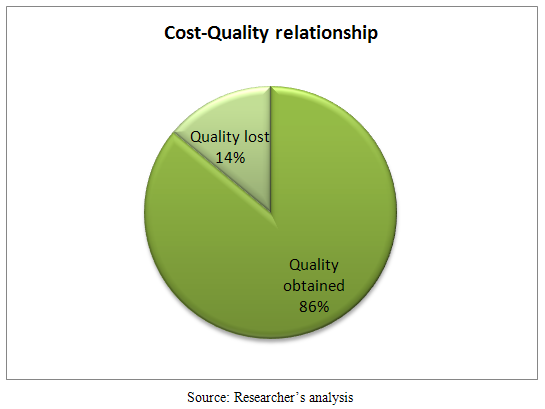 | Figure 1. Percentage of quality obtained and quality lost for project 16 |
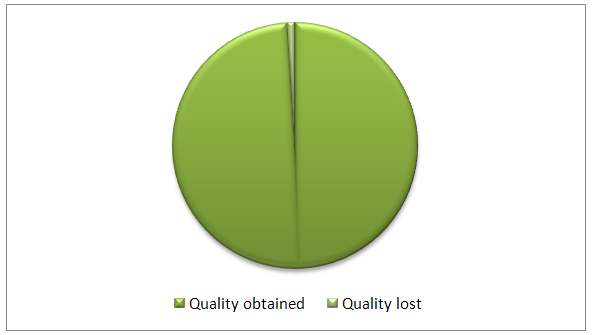 | Figure 2. Percentage of quality obtained and quality lost for project 10 |
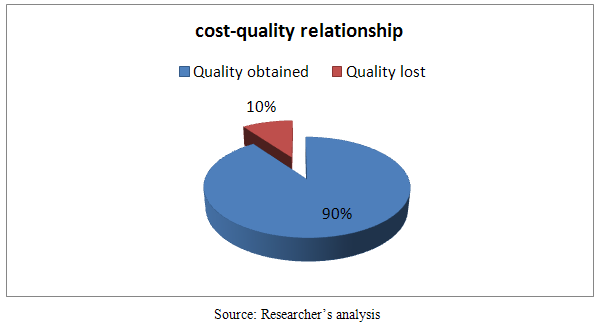 | Figure 3. Average quality obtained and quality lost in relation to cost of private building projects |
4.3. Summary of Findings
- Based on the results obtained from this research, it can be summarized that at a given cost, private building projects in Abuja are executed at a quality that is 10% lower than expected. In other words, only 90% of the expected quality is achieved in the execution of private building projects in Abuja.
5. Conclusions and Recommendations
- Review of previous research has shown that balancing time, cost and quality relationship in execution of building projects has always been a challenge. There are records of projects executed at a cost far higher than expected. Others suffer high percentage of delay whereas some suffer less attention been paid to quality.Based on the findings of this research, It was concluded that the resultant 10% loss of quality in relation to cost means that the required maximum attention needed has not been given to quality in relation to cost.The study however contributes to the body of knowledge by making the contractor/consultants know how to achieve maximum quality at an affordable cost, thereby ensuring high level of safety performance. Based on the research carried out, the following recommendation was made: As a result of loss of quality observed by this research, it is recommended that additional attention should be given to cost-quality relationship in executing private building projects in Abuja so as to eliminate lapses.
ACKNOWLEDGEMENTS
- We acknowledged the effort of Mr. Loya Osusha Samuel who helped to supply the data used in the research.
 Abstract
Abstract Reference
Reference Full-Text PDF
Full-Text PDF Full-text HTML
Full-text HTML